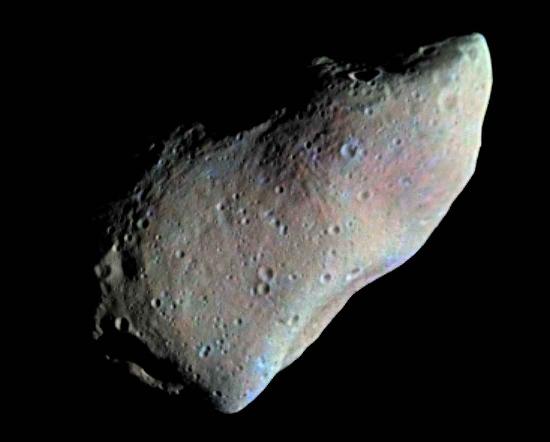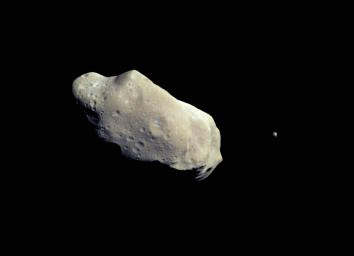Asteroids
Planetary positions had long been "known" to follow Bode's
Law (1772), where the semi-major axis of the planets are given by
a=(4+0)/10
a=(4+3)/10
a=(4+6)/10
a=(4+12)/10
a=(4+24)/10
etc...
| |
Mercury
|
Venus
|
Earth
|
Mars
|
???
|
Jupiter
|
Saturn
|
Uranus
|
Neptune
|
Pluto
|
|
Predicted
|
0.4
|
0.7
|
1.0
|
1.6
|
2.8
|
5.2
|
10.0
|
19.6
|
--
|
38.8
|
|
Actual
|
0.4
|
0.7
|
1.0
|
1.5
|
???
|
5.2
|
9.5
|
19.2
|
30.0
|
39.4
|
-
No physical basis -- just numerology.
-
Originally, only the first six planets were known -- Uranus's
discovery (1781) "confirmed" the law.
-
Neptune and Pluto shed doubt on Bode's law. It is now thought
by most astronomers to be a coincidence.
-
But a good one, nonetheless! So where is the planet between
Mars and Jupiter?
-
Search led to the discovery of small rocky bodies known as
asteroids!
Size distribution follows a power-law: 
-
Ceres is the biggest (r=900 km)
-
26 are > 200 km
-
we probably know 99% of asteroids > 100 km
-
there are probably millions out there > 1 km
Early theory: exploded
planet? Won't work:
-
physics: where would
the energy come from?
-
properties: total mass
< mass of Moon.
Better idea: Leftovers
from early solar system
Orbit classification:
-
Main Belt (2.5-4.5 AU)
-
Amors (Mars crossing
orbits)
-
Apollos (Earth crossing
orbits)
-
Atens (inside Earth's
orbit)
-
Outer Solar System:
-
Trojans (leading and
trailing Jupiter)
-
Centaurs (5.5 - 25 AU)
-
Kuiper Belt (at and beyond
Pluto)
Surface Features
For a long time we had very little idea what the surface
of asteroids looked like -- too small, too far away.
On the way to Jupiter, the Galileo probe photographed
the surface of a two asteroids - Gaspra
and Ida:
|
Gaspra
|
Ida
|

|

|
Ida has a moon! (called Dactyl)
(Ida: 58x23 km, Dactyl: 1.6x1.2 km)
Other asteroids do, too. 10-30%
of asteroids may have sizable moons (even
bigger than Dactyl).
Calculation of tidal evolution of
asteroid satellites shows rapid evolution.
-
Moons orbiting past synchronous rotation
will move outwards, eventually being lost from the parent asteroid.
-
Moons orbiting withing synchronous
rotation will move inwards, and collide with the asteroid.
-
Timescale: a few hundred thousand years.
-
Question 1: Why so fast?
-
Question 2: Are moons of
asteroids primordial?
Asteroid shapes
Many asteroids have dumbbell
shapes. Look again at Ida rotating.
Look also at the tumbling asteroid
Toutatis,
in this radar imaging movie.
The shapes suggests that many asteroids
are loosely bound clumps of a few large fragments.
How does this relate to what
we discussed about asteroid moons?



